
Triangulum Australe is a small constellation in the far Southern Celestial Hemisphere. Its name is Latin for "the southern triangle", which distinguishes it from Triangulum in the northern sky and is derived from the acute, almost equilateral pattern of its three brightest stars. It was first depicted on a celestial globe as Triangulus Antarcticus by Petrus Plancius in 1589, and later with more accuracy and its current name by Johann Bayer in his 1603 Uranometria. The French explorer and astronomer Nicolas Louis de Lacaille charted and gave the brighter stars their Bayer designations in 1756.
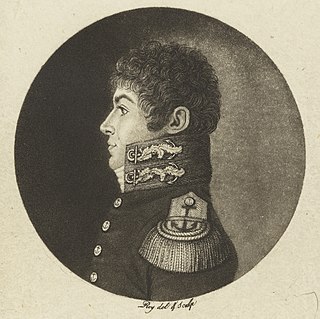
Louis Claude de Saulces de Freycinet was a French Navy officer. He circumnavigated the earth, and in 1811 published the first map to show a full outline of the coastline of Australia.

Castanospermum australe, the only species in the genus Castanospermum, is a flowering plant in the family Fabaceae, native to the east coast of Australia in Queensland and New South Wales, and to the Pacific islands of Vanuatu, New Caledonia, and the island of New Britain.

Acrophyllum australe is a woody flowering plant, native to a small area of New South Wales, Australia. A. australe is listed as a vulnerable species in the wild, by the Australian Department of the Environment and Heritage (DEH).

Fulgurotherium is a dubious genus of ornithischian dinosaur from the Late Cretaceous (Cenomanian) Griman Creek Formation. It lived in what is now Australia.
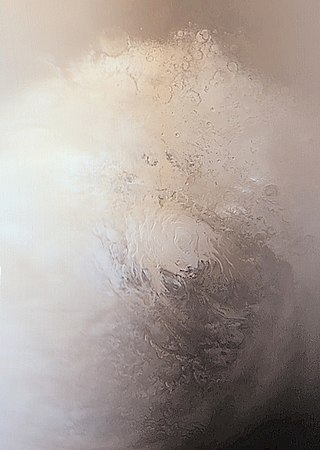
Planum Australe is the southern polar plain on Mars. It extends southward of roughly 75°S and is centered at 83.9°S 160.0°E. The geology of this region was to be explored by the failed NASA mission Mars Polar Lander, which lost contact on entry into the Martian atmosphere.

Etudes Australes is a set of etudes for piano solo by John Cage, composed in 1974–75 for Grete Sultan. It comprises 32 indeterminate pieces written using star charts as source material. The etudes, conceived as duets for two independent hands, are extremely difficult to play. They were followed by two more collections of similarly difficult works: Freeman Etudes for violin (1977–90) and Etudes Boreales (1978) for cello, or piano, or both together.

Syzygium australe, with many common names that include brush cherry, scrub cherry, creek lilly-pilly, creek satinash, and watergum, is a rainforest tree native to eastern Australia. It can attain a height of up to 35 m with a trunk diameter of 60 cm. In cultivation, this species is usually a small to medium-sized tree with a maximum height of only 18m.
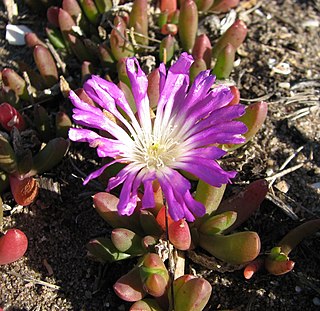
Disphyma is a genus of flowering plants in the family Aizoaceae that are native to New Zealand, Australia and southern Africa. Plants in this genus are prostrate, annual or short-lived perennial shrubs with succulent leaves and daisy-like flowers arranged singly on the ends of shoots with petal-like staminodes, many stamens and usually five styles.

Disphyma crassifolium subsp. clavellatum is the subspecies of Disphyma crassifolium that occurs in Australia and New Zealand. It is sometimes known by the common name rounded noon-flower

Australasia is a region that comprises Australia, New Zealand and some neighbouring islands in the Pacific Ocean. The term is used in a number of different contexts, including geopolitically, physiogeographically, philologically, and ecologically, where the term covers several slightly different, but related regions.
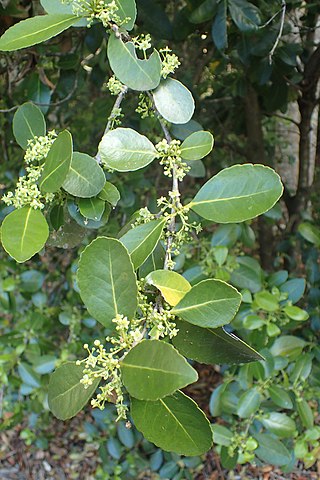
Elaeodendron australe, commonly known as red olive-berry, red-fruited olive plum, or blush boxwood, is a species of flowering plant in the family Celastraceae and is endemic to eastern Australia. It is a shrub or small tree with egg-shaped to oblong leaves with a wavy margin, yellowish green male and female flowers on separate plants and fleshy orange-red fruit.

The French Southern and Antarctic Territories is a French overseas territory consisting of Adélie Land in coastal Antarctica and several islands in the southern Indian Ocean: the Crozet Islands, the Kerguelen Islands, Amsterdam Island and Île Saint-Paul. The territory was created on 6 August 1955, before which all were dependencies of Madagascar.

Pentaceras australe, commonly known as bastard crow's ash, penta ash or black teak, is the only species in the genus Pentaceras in the plant family Rutaceae. It is a small to medium-sized rainforest tree endemic to eastern Australia. It has pinnate leaves with up to fifteen leaflets, small white flowers arranged in panicles on the ends of branchlets, and winged seeds.
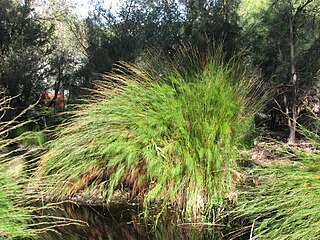
Baloskion is a genus of rush-like plants from Australia.

Pelargonium australe is a perennial herb that is endemic to Australia, and found in all states except the Northern Territory. Common names include native storksbill, wild geranium and austral storksbill. The species grows to 50 cm high and has leaves with 5 to 7 lobes. Umbels of 4 to 12 flowers appear between October and March in the species' native range. These are pink with darker markings.

Metalegoceras is an extinct genus of marine cephalopods belonging to the family Schistoceratidae.
Italian Studies in Southern Africa/Studi d'Italianistica nell'Africa Australe is a biannual peer-reviewed academic journal published by the Association of Professional Italianists in South Africa/Associazione di Professori d'Italiano in Sudafrica. It is published in Italian and English and covers the field of Italian studies.

Baloskion gracile is a species of perennial herb found near Sydney in Australia. A rush with stems from 30 to 100 cm tall. The preferred habitat is wet, sandy soil. This is one of the many plants first published by Robert Brown with the type known as "(J. D.) v.v." appearing in his Prodromus Florae Novae Hollandiae et Insulae Van Diemen in 1810. The specific epithet gracile meaning slender, refers to the thin stems.

Lycium australe, the Australian boxthorn, is a native Australian plant with large sharp woody spines, small leaves and very small berries. It is closely related to Lycium ferocissimum, which is listed as an invasive weed in Australia, New Zealand and Cyprus.

















